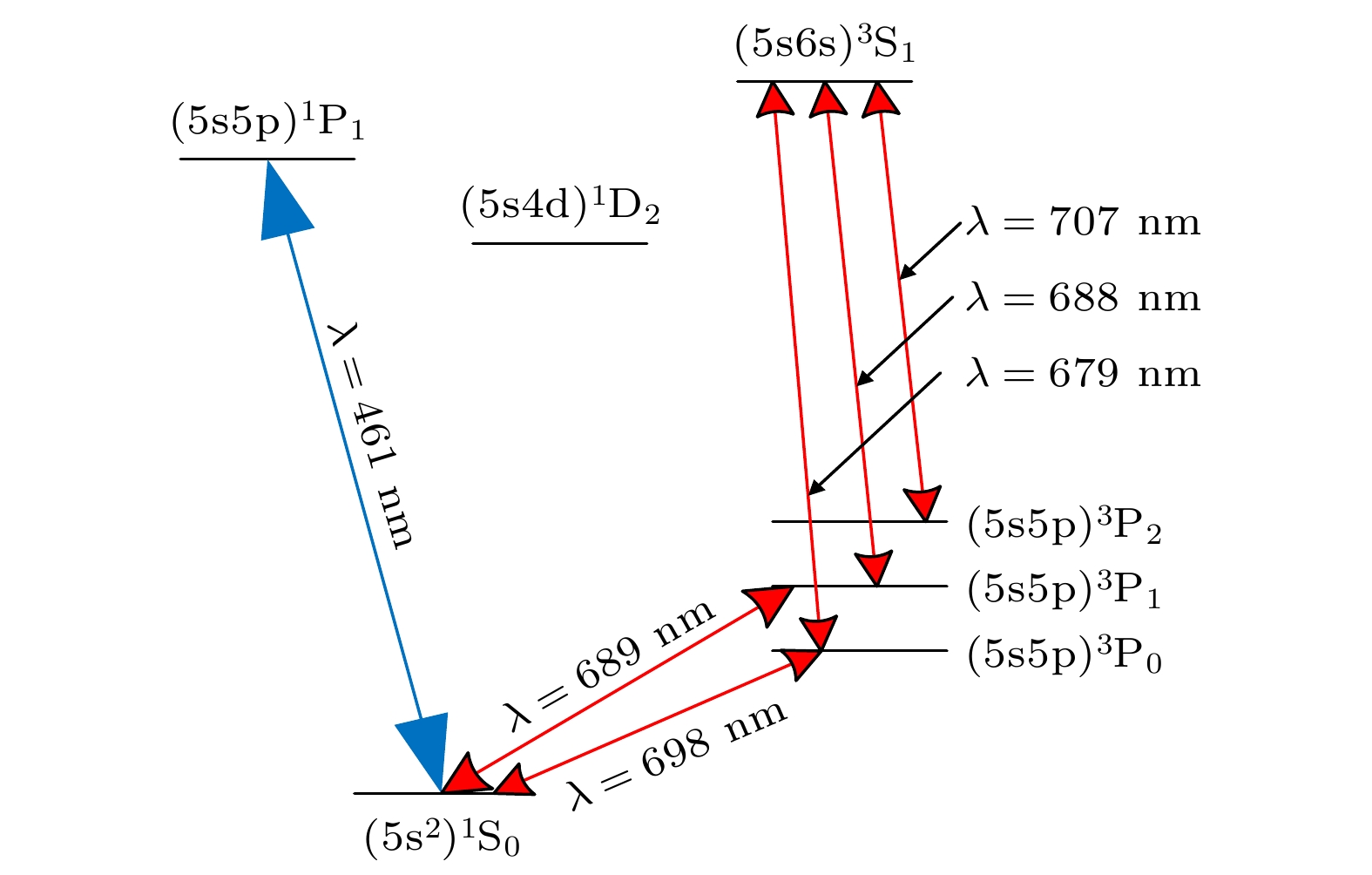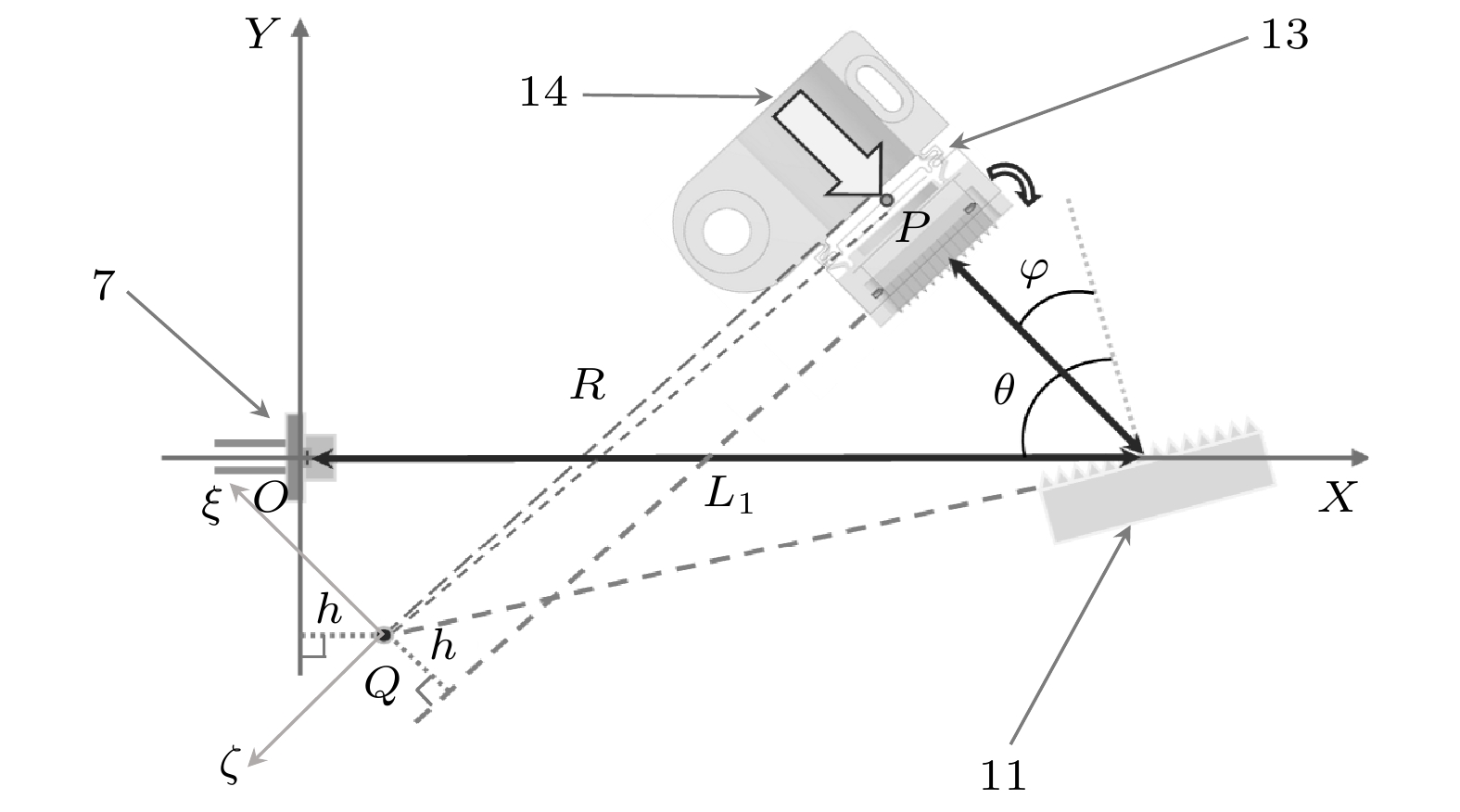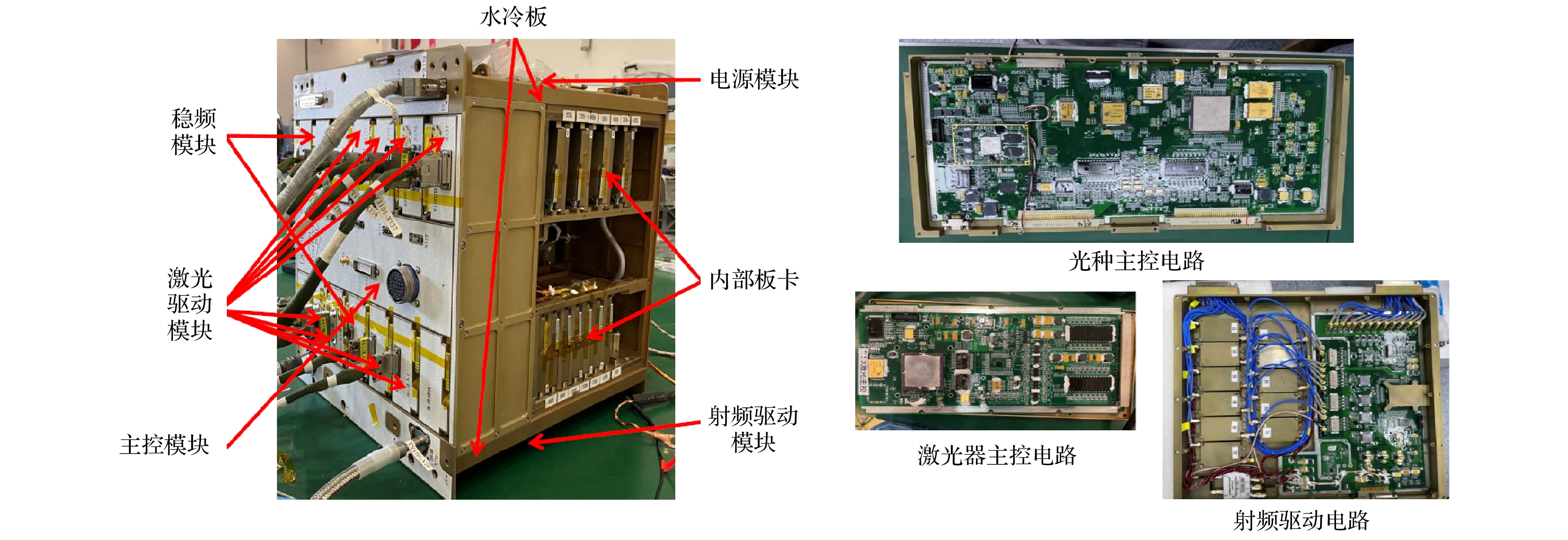-
The world's first space optical clock (SOC) developed in China, which is composed of five subsystems, i.e. an optical unit, a physics unit, an electronic control unit, a space optical frequency comb, and an ultrastable laser, was successfully launched with the Mengtian space laboratory on October 31, 2022, and entered into the China Space Station (CSS). Compact and stable laser is a key element for the operation of the SOC. The optical unit consists of 5 lasers with wavelengths of 461, 679, 689, 707 and 813 nm, respectively. With a synchronous-tuning-like scheme, high-quality external cavity diode lasers (ECDLs) are developed as the seeds. The linewidths of the lasers are all reduced to approximately 100 kHz, and their tuning ranges, free from mode hopping, are capable of reaching 20 GHz, satisfying the requirements for the SOC. With careful mechanical and thermal design, the stability of the laser against vibration and temperature fluctuation is sufficiently promoted to confront the challenge of rocket launching. While the power from the ECDL is sufficient for 679-nm repump laser and 707-nm repump laser, additional injection lock is utilized for the 461-nm laser and 689-nm laser to amplify the power of the seeds to more than 600 mW, so that effective first and second stage Doppler cooling can be achieved. To generate an optical lattice with deep enough potential well, over 800-mW 813-nm lasers are required. Therefore, a semiconductor tapered amplifier is adopted to amplify the seed to more than 2 W, so as to cope with various losses of the coupling optics. The wavelengths and output power values of the 5 lasers are monitored and feedback is controlled by the electronic control unit. All the modules are designed and prepared as orbital replaceable units, which can be easily replaced by astronauts in case failure occurs. Now the lasers are all turned on and operate normally in CSS. More data of the SOC will be obtained in the near future. At present stage, according to our evaluation, the continuous operation time of the SOC is limited by the injection locked lasers, which are relatively vulnerable to mode hopping. Hopefully, this problem can be solved by improving the laser diode preparing technology, or developing fiber lasers with compact frequency conversion modules.
-
Keywords:
- cold atom optical clock /
- China Space Station /
- laser system /
- control system
[1] Mallette L A, White J, Rochat P 2010 IEEE/ION Position, Location and Navigation Symposium Indian Wells, CA, USA, May 4–6, 2010 p11414524
[2] Batori E, Almat N, Affolderbach C, Mileti G 2021 Adv. Space Res. 68 4723
 Google Scholar
Google Scholar
[3] Thornton C L, Border J S 2003 Radiometric Tracking Techniques for Deep-Space Navigation (New York: Wiley-Interscience) pp28–31
[4] Wolf P, Blanchet L 2016 Classical Quantum Gravity 33 035012
 Google Scholar
Google Scholar
[5] Liu, L, Lyu D S, Chen W B, Li T, Qu Q Z, W B, Li L, Ren W Dong Z R, Zhao J B, Xia W B, Zhao X, Ji J W, Ye M F, Sun Y G, Yao Y Y, Song D, Liang Z G, Hu S J, Yu D H, Hou X, Shi W, Zang H G, Xiang J F, Peng X K, Wang Y Z 2018 Nat. Commun. 9 2760
 Google Scholar
Google Scholar
[6] Burt E A, Prestage J D, Tjoelker R L, Enzer D G, Kuang D, Murphy D W, Robison D E, Seubert J M, Wang R T, Ely T A 2021 Nature 595 43
[7] Schiller S, Gorlitz A, Nevsky A, Alighanbari S, Vasilyev S, Abou-Jaoudeh C, Mura G, Franzen T, Sterr U, Falke S, Lisdat C, Rasel E, Kulosa A, Bize S, Lodewyck , Tino G M, Poli N, Schioppo M, Bongs K, Singh Y, Gill P, Barwood G, Ovchinnikov Y, Stuhler J, Kaenders W, Braxmaier C, Holzwarth R, Donati A, Lecomte S, Calonico D, Levi F 2012 European Frequency and Time Forum, Gothenburg, Sweden, April 23–27, 2012, p412
[8] Bongs K, Singh, Smith L, He W, Kock O, Swierad D, Hughes J, Schiller S, Alighanbari S, Origlia S, Vogt S, Sterr O, Lisdat C, Le Targat R, Lodewyck J, Holleville D, Venon B, Bize S, Barwood G P, Gill P, Hill I R, Ovchinnikov Y B, Poli N , Tino G M , Stuhler J , Kaenders W 2015 C. R. Phys. 16 553
[9] Khabarova K, Kryuchkov D, Borisenko A, Zalivako I, Semerikov I, Aksenov M, Sherstov I, Abbasov T, Tausenev A, Kolachevsky N 2022 Symmetry 14 2213
 Google Scholar
Google Scholar
[10] Ohmae N, Takamoto M, Takahashi Y, Kokubun M, Araki K, Hinton A, Ushijima I, Muramatsu T, Furumiya T, Sakai Y, Moriya N, Kamiya N, Fujii K, Muramatsu R, Shiimado T, Katori H 2021 Adv. Quantum Technol. 4 2100015
 Google Scholar
Google Scholar
[11] 赵芳婧, 高峰, 韩建新, 周驰华, 孟俊伟, 王叶兵, 郭阳, 张首刚, 常宏 2018 67 050601
 Google Scholar
Google Scholar
Zhao F J, Gao F, Han J X, Zhou C H, Meng J W, Wang Y B, Guo Y, Zhang S G, Chang H 2018 Acta Phys. Sin. 67 050601
 Google Scholar
Google Scholar
[12] Krebs D J, Novo-Gradac A M, Li S X, Lindauer S J, Afzal R S, Yu A W 2005 Appl. Opt. 44 1715
 Google Scholar
Google Scholar
[13] Yu A W, Krainak M A, Stephen M A, Chen J R, Coyle B, Numata K, Camp J B, Abshire J B, Allan G R, Li S X, Riris H 2012 Fiber Lasers IX: Technology, Systems, and Applications, San Francisco, California, United States, February 15, 2012 p823713
[14] Lévèque T, Faure B, Esnault F, Delaroche C, Massonnet D, Grosjean O, Buffe F, Torresi P, Bomer T, Pichon A, Béraud P, Lelay J, Thomin S, Laurent P 2015 Rev. Sci. Instrum. 86 033104
 Google Scholar
Google Scholar
[15] Lezius M, Wilken T, Deutsch C, Giunta M, Mandel O, Thaller A, Schkolnik V, Schiemangk M, Dinkelaker A, Kohfeldt A, Wicht A, Krutzik M, Peters A, Hellmig O, Duncker H, Sengstock K, Windpassinger P, Lampmann K, Hülsing T, Hänsch T, Holzwarth R 2016 Optica 3 1381
[16] Dinkelaker A N, Schiemangk M, Schkolnik V, Kenyon A, Lampmann K, Wenzlawski A, Windpassinger P, Hellmig O, Wendrich T, Rasel E M, Giunta M, Deutsch C, Kürbis C, Smol R, Wicht A, Krutzik M, Peters A 2017 Appl. Opt. 56 1388
 Google Scholar
Google Scholar
[17] Schwarz R, Dorscher S, Al-Masoudi A, Vogt S, Li Y, Lisdat C 2019 Rev. Sci. Instrum. 90 023109
 Google Scholar
Google Scholar
[18] Sottile A, Damiano E, Di Lieto A, Tonelli M 2019 Opt. Lett. 44 594
 Google Scholar
Google Scholar
[19] Meng L Q, Zhao P Y, Meng F C, Long Chen, Xie Y, Wang Y K, Bian W, Jia J J, Liu T, Zhang S G, Wang J Y 2022 Chin. Opt. Lett. 20 021407
 Google Scholar
Google Scholar
[20] 邹宏新, 王文海, 詹子豪 2021 国专利 ZL 202110005798.9 [2021-01-05]
Zou H X, Wang W H, Zhan Z H 2021 CN Patent ZL 202110005798.9 [2021-01-05
[21] 邹宏新, 詹子豪, 王文海 2021 中国专利 ZL 202110005871.2 [2021-01-05]
Zou H X, Zhan Z H, Wang W H 2021 CN Patent ZL 202110005871.9 [2021-01-05
[22] Shaffer M K, Ranjit G, Sukenik C I 2008 Rev. Sci. Instrum. 79 046102
[23] Guo F, Tan W, Zhou C H, Xia J, Chen Y X, Liang T, Liu Q, Liu Y, He D J, Zhou Y Z, Wang W H, Shen Y, Zou H X, Chang H 2021 AIP Adv. 11 125116
-
图 4 Littman结构光栅ECDL的工作原理图(P, 压电陶瓷作用点; θ, 光栅入射角; φ, 光栅一级衍射角; R, 理想旋转半径; L2, 实际旋转半径; h, 调谐点与Y轴的垂直距离; Q, 调谐支点)
Fig. 4. Functional schematic of Littman-configuration ECDL. (P, PZT action point; θ, grating incident angle; φ, first order diffraction angle of grating; R, ideal rotation radius; L2, actual rotation radius; h, the distance between the pivot point and the Y coordinate axis; Q, pivot point)
-
[1] Mallette L A, White J, Rochat P 2010 IEEE/ION Position, Location and Navigation Symposium Indian Wells, CA, USA, May 4–6, 2010 p11414524
[2] Batori E, Almat N, Affolderbach C, Mileti G 2021 Adv. Space Res. 68 4723
 Google Scholar
Google Scholar
[3] Thornton C L, Border J S 2003 Radiometric Tracking Techniques for Deep-Space Navigation (New York: Wiley-Interscience) pp28–31
[4] Wolf P, Blanchet L 2016 Classical Quantum Gravity 33 035012
 Google Scholar
Google Scholar
[5] Liu, L, Lyu D S, Chen W B, Li T, Qu Q Z, W B, Li L, Ren W Dong Z R, Zhao J B, Xia W B, Zhao X, Ji J W, Ye M F, Sun Y G, Yao Y Y, Song D, Liang Z G, Hu S J, Yu D H, Hou X, Shi W, Zang H G, Xiang J F, Peng X K, Wang Y Z 2018 Nat. Commun. 9 2760
 Google Scholar
Google Scholar
[6] Burt E A, Prestage J D, Tjoelker R L, Enzer D G, Kuang D, Murphy D W, Robison D E, Seubert J M, Wang R T, Ely T A 2021 Nature 595 43
[7] Schiller S, Gorlitz A, Nevsky A, Alighanbari S, Vasilyev S, Abou-Jaoudeh C, Mura G, Franzen T, Sterr U, Falke S, Lisdat C, Rasel E, Kulosa A, Bize S, Lodewyck , Tino G M, Poli N, Schioppo M, Bongs K, Singh Y, Gill P, Barwood G, Ovchinnikov Y, Stuhler J, Kaenders W, Braxmaier C, Holzwarth R, Donati A, Lecomte S, Calonico D, Levi F 2012 European Frequency and Time Forum, Gothenburg, Sweden, April 23–27, 2012, p412
[8] Bongs K, Singh, Smith L, He W, Kock O, Swierad D, Hughes J, Schiller S, Alighanbari S, Origlia S, Vogt S, Sterr O, Lisdat C, Le Targat R, Lodewyck J, Holleville D, Venon B, Bize S, Barwood G P, Gill P, Hill I R, Ovchinnikov Y B, Poli N , Tino G M , Stuhler J , Kaenders W 2015 C. R. Phys. 16 553
[9] Khabarova K, Kryuchkov D, Borisenko A, Zalivako I, Semerikov I, Aksenov M, Sherstov I, Abbasov T, Tausenev A, Kolachevsky N 2022 Symmetry 14 2213
 Google Scholar
Google Scholar
[10] Ohmae N, Takamoto M, Takahashi Y, Kokubun M, Araki K, Hinton A, Ushijima I, Muramatsu T, Furumiya T, Sakai Y, Moriya N, Kamiya N, Fujii K, Muramatsu R, Shiimado T, Katori H 2021 Adv. Quantum Technol. 4 2100015
 Google Scholar
Google Scholar
[11] 赵芳婧, 高峰, 韩建新, 周驰华, 孟俊伟, 王叶兵, 郭阳, 张首刚, 常宏 2018 67 050601
 Google Scholar
Google Scholar
Zhao F J, Gao F, Han J X, Zhou C H, Meng J W, Wang Y B, Guo Y, Zhang S G, Chang H 2018 Acta Phys. Sin. 67 050601
 Google Scholar
Google Scholar
[12] Krebs D J, Novo-Gradac A M, Li S X, Lindauer S J, Afzal R S, Yu A W 2005 Appl. Opt. 44 1715
 Google Scholar
Google Scholar
[13] Yu A W, Krainak M A, Stephen M A, Chen J R, Coyle B, Numata K, Camp J B, Abshire J B, Allan G R, Li S X, Riris H 2012 Fiber Lasers IX: Technology, Systems, and Applications, San Francisco, California, United States, February 15, 2012 p823713
[14] Lévèque T, Faure B, Esnault F, Delaroche C, Massonnet D, Grosjean O, Buffe F, Torresi P, Bomer T, Pichon A, Béraud P, Lelay J, Thomin S, Laurent P 2015 Rev. Sci. Instrum. 86 033104
 Google Scholar
Google Scholar
[15] Lezius M, Wilken T, Deutsch C, Giunta M, Mandel O, Thaller A, Schkolnik V, Schiemangk M, Dinkelaker A, Kohfeldt A, Wicht A, Krutzik M, Peters A, Hellmig O, Duncker H, Sengstock K, Windpassinger P, Lampmann K, Hülsing T, Hänsch T, Holzwarth R 2016 Optica 3 1381
[16] Dinkelaker A N, Schiemangk M, Schkolnik V, Kenyon A, Lampmann K, Wenzlawski A, Windpassinger P, Hellmig O, Wendrich T, Rasel E M, Giunta M, Deutsch C, Kürbis C, Smol R, Wicht A, Krutzik M, Peters A 2017 Appl. Opt. 56 1388
 Google Scholar
Google Scholar
[17] Schwarz R, Dorscher S, Al-Masoudi A, Vogt S, Li Y, Lisdat C 2019 Rev. Sci. Instrum. 90 023109
 Google Scholar
Google Scholar
[18] Sottile A, Damiano E, Di Lieto A, Tonelli M 2019 Opt. Lett. 44 594
 Google Scholar
Google Scholar
[19] Meng L Q, Zhao P Y, Meng F C, Long Chen, Xie Y, Wang Y K, Bian W, Jia J J, Liu T, Zhang S G, Wang J Y 2022 Chin. Opt. Lett. 20 021407
 Google Scholar
Google Scholar
[20] 邹宏新, 王文海, 詹子豪 2021 国专利 ZL 202110005798.9 [2021-01-05]
Zou H X, Wang W H, Zhan Z H 2021 CN Patent ZL 202110005798.9 [2021-01-05
[21] 邹宏新, 詹子豪, 王文海 2021 中国专利 ZL 202110005871.2 [2021-01-05]
Zou H X, Zhan Z H, Wang W H 2021 CN Patent ZL 202110005871.9 [2021-01-05
[22] Shaffer M K, Ranjit G, Sukenik C I 2008 Rev. Sci. Instrum. 79 046102
[23] Guo F, Tan W, Zhou C H, Xia J, Chen Y X, Liang T, Liu Q, Liu Y, He D J, Zhou Y Z, Wang W H, Shen Y, Zou H X, Chang H 2021 AIP Adv. 11 125116
计量
- 文章访问数: 10168
- PDF下载量: 317
- 被引次数: 0














 下载:
下载:










